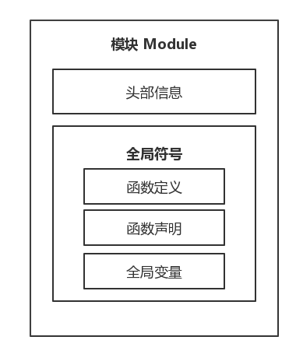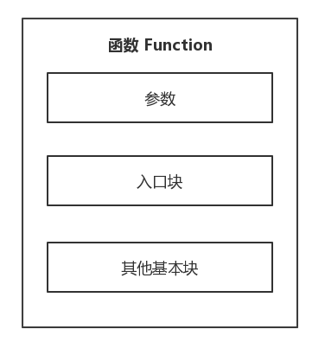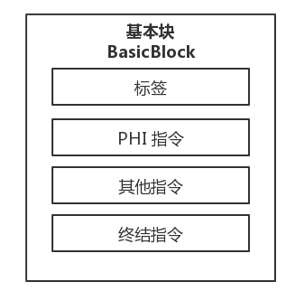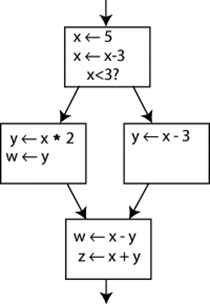写在前面
随便学学 llvm 代码混淆,顺便做个毕设,水几篇文章就当做做笔记
LLVM IR 概述
- 低级编程语言,类似汇编
- 任何高级编程语言都可以用 LLVM IR 表示
- 基于 LLVM IR 可以进行代码优化
两种表示方法
- 人类可以阅读的文本形式,文件后缀为
.ll
- 易于机器处理的二进制格式,文件后缀为
.bc
用llvm-dis和llvm-as可以相互转化

结构
源代码被编译为 LLVM IR 后,具有模块 Module,函数 Function和基本块 BasicBlock
模块

- 一个源代码文件对应一个模块
- 头部信息包含程序的目标平台,如 x86、arm 等,和一些其他信息
- 全局符号包含全局变量、函数的定义与声明
函数

- 函数指的是源代码中的某个函数
- 参数即函数的参数
- 一个函数由若干基本块组成,其中函数最先执行的基本块为入口块
基本块

- 一个基本块由若干指令和标签组成
- 正常情况下,基本块的最后一条指令为跳转指令(br 或 switch),或返回指令(retn),也叫作终结指令(Terminator Instruction)
- PHI 指令是一种特殊的指令
代码混淆
基于 LLVM 的混淆,通常是以函数或者比函数更小的单位为基本单位进行混淆的,我们通常更关心函数和基本块这两个结构
- 以函数为基本单位的混淆:控制流平坦化
- 以基本块基本单位的混淆:虚假控制流
- 以指令为基本单位的混淆:指令替代
LLVM IR 常用指令含义及其用法
终结指令 Terminator Instructions
ret 指令
- 函数的返回指令,对应 C/C++ 中的 return
1
2
3
4
5
6
| ret <type> <value> ; 返回特定类型返回值的 return 指令
ret void ; 无返回值的 return 指令
例:
ret i32 5 ; 返回整数 5
ret void ; 无返回值
ret { i32, i8 } { i32 4, i8 2 } ; 返回一个结构体
|
br 指令
- br 是”分支”的英文 branch 的缩写,分为非条件分支和条件分支,对应 C/C++ 的 if 语句
- 无条件分支类似于x86汇编中的 jmp 指令,条件分支类似于x86汇编中的 jnz, je 等条件跳转指令
1
2
3
4
5
6
7
8
9
10
| br i1 <cond>, label <iftrue>, label <iffalse> ; 条件分支,i1 是条件,1 位整数
br label <dest> ; 无条件分支
例:
Test:
%cond = icmp eq i32 %a, %b;
br i1 %cond, label %IfEqual, label %IfUnequal
IfEqual:
ret i32 1
IfUnEqual:
ret i32 0
|
swtich 指令
- 分支指令,可看做是 br 指令的升级版,支持的分支更多,但使用也更复杂。对应 C/C++ 中的 switch
1
2
3
4
5
6
7
8
9
10
11
12
13
| switch <intty> <value>, label <defaultdest> [ <intty> <val>, label <dest> ...]
例:
; 与条件跳转等效
%Val = zext i1 %value to i32
switch i32 %Val, label %truedest [ i32 0, label %falsedest ]
; 与非条件跳转等效
switch i32 0, label %dest [ ]
; 拥有三个分支的条件跳转
switch i32 %val, label %otherwise [ i32 0, label %onzero
i32 1, label %onone
i32 2, label %ontwo ]
|
比较指令 Compere Instructions
常与 br 指令一起使用,如:cmp、switch、test
icmp 指令
- 整数或指针的比较指令
- 条件 cond 可以是 eq(相等),ne(不相等),ugt(无符号大于)等等
1
2
3
4
5
6
7
8
| <result> = icmp <cond> <type> <op1>, <op2> ; 比较整数 op1 和 op2 是否满足条件 cond
例:
<result> = icmp eq i32 4, 5 ; yields: result=false eq=equal(相等)
<result> = icmp ne float* %X, %X; yields: result=false ne=not equal(不相等)
<result> = icmp ult i16 4, 5 ; yields: result=true ult=unsigned less than(无符号小于)
<result> = icmp sgt i16 4, 5 ; yields: result=false sgt=signed greater than(有符号大于)
<result> = icmp ule i16 -4, 5 ; yields: result=false ule=unsigned less or equal(无符号小于等于)
<result> = icmp sge i16 4, 5 ; yields: result=false sge=signed greater or equal(有符号大于等于)
|
fcmp 指令
- 浮点数的比较指令
- 条件 cond 可以是 oeq(ordered and equal), ueq(unordered or equal), false(必定不成立)等等
- ordered 的意思是,两个操作数都不能为 NAN
1
2
3
4
5
6
| <result> = fcmp <cond> <type> <op1>, <op2> ; 比较浮点数 op1 和 op2 是否满足条件 cond
例:
<result> = fcmp oeq float 4.0, 5.0 ; yields: result = false
<result> = fcmp one float 4.0, 5.0 ; yields: result = true
<result> = fcmp olt float 4.0, 5.0 ; yields: result = true
<result> = fcmp ueq double 1.0, 2.0 ; yields: result = false
|
二元运算 Binary Operations
add 指令
- 整数加法指令,对应 C/C++ 中的“+”操作符,类似x86汇编中的 add 指令
1
2
3
| <result> = add <type> <op1>, <op2>
例:
<result> = add i32 4, %var ; yields i32:result = 4 + %var
|
sub 指令
- 整数减法指令,对应 C/C++ 中的“-”操作符,类似x86汇编中的 sub 指令
1
2
3
4
| <result> = sub <type> <op1>, <op2>
例:
<result> = sub i32 4, %var ; yields i32:result = 4 - %var
<result> = sub i32 0, %var ; yields i32:result = -%var
|
mul 指令
- 整数乘法指令,对应 C/C++ 中的“*”操作符,类似x86汇编中的 mul 指令
1
2
3
| <result> = mul <type> <op1>, <op2>
例:
<result> = mul i32 4, %var ; yields i32:result = 4 * %var
|
udiv 指令
- 无符号整数除法指令,对应 C/C++ 中的“/”操作符。如果存在exact关键字,且op1不是op2的倍数,就会出现错误
1
2
3
4
| <result> = udiv <type> <op1>, <op2> ; yields type:result
<result> = udiv exact <type> <op1>, <op2> ; yields type:result
例:
<result> = udiv i32 4, %var ; yields i32:result = 4 / %var
|
sdiv 指令
- 有符号整数除法指令,对应 C/C++ 中的“/”操作符
1
2
3
4
| <result> = sdiv <type> <op1>, <op2> ; yields type:result
<result> = sdiv exact <type> <op1>, <op2> ; yields type:result
例:
<result> = sdiv i32 4, %var ; yields i32:result = 4 / %var
|
urem 指令
- 无符号整数取余指令,对应 C/C++ 中的“%”操作符
1
2
3
| <result> = urem <type> <op1>, <op2> ; yields type:result
例:
<result> = urem i32 4, %var ; yields i32:result = 4 % %var
|
srem 指令
- 有符号整数取余指令,对应 C/C++ 中的“%”操作符
1
2
3
| <result> = srem <type> <op1>, <op2> ; yields type:result
例:
<result> = srem i32 4, %var ; yields i32:result = 4 % %var
|
按位二元运算 Bitwise Binary Operations
shl 指令
- 整数左移指令,对应 C/C++ 中的“<<”操作符,类似x86汇编中的 shl 指令
1
2
3
4
5
6
7
| <result> = shl <type> <op1>, <op2>
例:
<result> = shl i32 4, %var ; yields i32:result 4 << %var
<result> = shl i32 4, 2 ; yields i32:result 16
<result> = shl i32 1, 10 ; yields i32:result 1024
<result> = shl i32 1, 32 ; undefined
<result> = shl <2 x i32> < i32 1, i32 1>, < i32 1, i32 2> ; yields: result = <2 x i32> < i32 2, i32 4>
|
lshl 指令
- 整数逻辑右移指令,对应 C/C++ 中的“>>”操作符,右移指定位数后在左侧补0
1
2
3
4
5
6
7
8
9
| <result> = lshl <type> <op1>, <op2>
例:
<result> = lshl i32 4, 1 ; yields i32:result 2
<result> = lshl i32 4, 2 ; yields i32:result 1
<result> = lshl i8 4, 3 ; yields i8:result 0
<result> = lshl i8 -2, 1 ; yields i8:result 0x7F
<result> = lshl i32 1, 32 ; underfined
<result> = lshl <2 x i32> < i32 -2, i32 4>, < i32 1, i32 2>; yields: result = <2 x i32> < i32 0x7FFFFFFF, i32 1>
|
ashr 指令
- 整数算数右移指令,右移指定位数后在左侧补符号位(负数的符号位为1,正数的符号位为0)
1
2
3
4
5
6
7
8
| <result> = ashl <type> <op1>, <op2>
例:
<result> = ashl i32 4, 1 ; yields i32:result 2
<result> = ashl i32 4, 2 ; yields i32:result 1
<result> = ashl i8 4, 3 ; yields i8:result 0
<result> = ashl i8 -2, 1 ; yields i8:result -1
<result> = ashl i32 1, 32 ; underfined
<result> = ashl <2 x i32> < i32 -2, i32 4>, < i32 1, i32 3>; yields: result = <2 x i32> < i32 -1, i32 0>
|
and 指令
- 整数按位与运算指令,对应 C/C++ 中的“&”操作符。
1
2
3
4
5
| <result> = and <type> <op1>, <op2> ; yields type:result
例:
<result> = and i32 4, %var ; yields i32:result = 4 & %var
<result> = and i32 15, 40 ; yields i32:result = 8
<result> = and i32 4, 8 ; yields i32:result = 0
|
or 指令
- 整数按位或运算指令,对应 C/C++ 中的“|”操作符
1
2
3
4
5
| <result> = or <type> <op1>, <op2> ; yields type:result
例:
<result> = or i32 4, %var ; yields i32:result = 4 | %var
<result> = or i32 15, 40 ; yields i32:result = 47
<result> = or i32 4, 8 ; yields i32:result = 12
|
xor 指令
- 整数按位异或运算指令,对应 C/C++ 中的“^”操作符
1
2
3
4
5
6
| <result> = xor <type> <op1>, <op2> ; yields type:result
例:
<result> = xor i32 4, %var ; yields i32:result = 4 ^ %var
<result> = xor i32 15, 40 ; yields i32:result = 39
<result> = xor i32 4, 8 ; yields i32:result = 12
<result> = xor i32 %V, -1 ; yields i32:result = ~%V
|
内存访问和寻址操作 Memory Access and Addressing Operations
静态单赋值
- 在编译器设计中,静态单赋值(Static Single Assignment, SSA),是 IR 的一种属性
- SSA 的特点是:在程序中一个变量仅能有一条赋值语句
- LLVM IR 正是基于静态单赋值原则设计的
在下面这个程序流程图中,变量 x, y, w 都被赋值了两次,不满足 SSA

在下面这个程序流程图中,所有变量都只被赋值了一次,满足 SSA

由 SSA 引起的问题
假设 C++ 也是基于静态单赋值原则的(即一个变量只能被赋值一次),要怎样修改这个 for 循环,使其符合 SSA 原则?
1
2
3
4
5
6
7
| #include <cstdio>
int main(){
for(int i = 0;i < 100;i ++){
printf("Hello, %d\n", i);
}
}
|
以下是一种实现方式,也是 LLVM IR 采取的实现方式。在LLVM IR 中也有类似 malloc 和 指针操作 的指令
1
2
3
4
5
6
7
8
9
| #include <cstdio>
#include <cstdlib>
int main(){
int *i = (int*)malloc(4);
for(*i = 0; *i < 100; (*i) ++){
printf("Hello, %d\n", *i);
}
}
|
alloca 指令
- 内存分配指令,在栈中分配一块空间并获得指向该空间的指针,类似于 C/C++ 中的 malloc 函数
1
2
3
4
5
6
| <result> = alloca <type> [, <type> <NumElements>] [, align <alignment>]; 分配sizeof(type)*NumElements 字节的内存,分配地址与 alignment 对齐
例:
%ptr = alloca i32; 分配 4 字节的内存并返回 i32 类型的指针
%ptr = alloca i32, i32 4; 分配 4*4 字节的内存并返回 i32 类型的指针
%ptr = alloca i32, i32 4, align 1024; 分配 4*4 字节的内存并返回 i32 类型的指针,分配的地址与 1024 对齐
%ptr = alloca i32, align 1024; 分配 4 字节的内存并返回 i32 类型的指针,分配的地址与 1024 对齐
|
store 指令
- 内存存储指令,向指针指向的内存中存储数据,类似于 C/C++ 中的指针解引用后的赋值操作
1
2
3
4
| store <type> <value>, <type>* <pointer>; 向特定类型指针指向的内存存储相同类型的数据
例:
%ptr = alloca i32 ; yields i32*:ptr
store i32 3, i32* %ptr ; yields void
|
load 指令
- 内存读取指令,从指针指向的内存中读取数据,类似于 C/C++ 中的指针解引用操作
1
2
3
4
5
| result = load <type>, <type>* <pointer>; 从特定类型指针指向的内存中读取特定类型的数据
例:
%ptr = alloca i32 ; yields i32*:ptr
store i32 3, i32* %ptr ; yields void
%val = load i32, i32* %ptr ; yields i32:val = i32 3
|
类型转换操作 Conversion Operations
trunc .. to 指令
- u截断指令,将一种类型的变量截断为另一种类型的变量。对应 C/C++ 中大类型向小类型的强制转换(比如 long 强转 int)
1
2
3
4
5
6
| <result> = trunc <type1> <value> to <type2> ; 将 type1 类型的变量截断为 type2 类型的变量
例:
%X = trunc i32 257 to i8 ; yields i8:1
%Y = trunc i32 123 to i1 ; yields i1:true
%Z = trunc i32 122 to i1 ; yields i1:false
%W = trunc i32 <2 x i16> <i16 8, i16 7> to <2 x i8>; yields <i8 8, i8 7>
|
zext .. to 指令
- 零拓展(Zero Extend)指令,将一种类型的变量拓展为另一种类型的变量,高位补0。对应 C/C++ 中小类型向大类型的强制转换(比如 int 强转 long)
1
2
3
4
5
| <result> = zext <type1> <value> to <type2> ; 将 type1 类型的变量拓展为 type2 类型的变量
例:
%X = zext i32 257 to i64 ; yields i64:257
%Y = zext i1 true to i32 ; yields i32:1
%Z = zext <2 x i16> <i16 8, i16 7> to <2 x i32> ; yields <i32 8, i32 7>
|
sext .. to 指令
- 符号位拓展(Sign Extend)指令,通过复制符号位(最高位)将一种类型的变量拓展为另一种类型的变量
1
2
3
4
5
| <result> = sext <type1> <value> to <type2> ; 将 type1 类型的变量拓展为 type2 类型的变量
例:
%X = sext i8 -1 to i16 ; yields i16:-1
%Y = sext i1 true to i32 ; yields i32:-1
%Z = sext <2 x i16> <i16 8, i16 7> to <2 x i32> ; yields <i32 8, i32 7>
|
其他操作 Other Operations
phi 指令
由静态单赋值引起的问题:在最后一个基本块中,我们怎么知道应该使用 y1 变量还是y2 变量呢?

u通过引入 Φ 函数来解决这个问题,Φ 函数的值由前驱块决定,这里的 Φ 函数对应 LLVM IR 中的 phi 指令:

- phi 指令可以看做是为了解决 SSA 一个变量只能被赋值一次而引起的问题衍生出的指令
- phi 指令的计算结果由 phi 指令所在的基本块的 前驱块 确定
1
2
3
4
5
6
| <result> = phi <type> [ <val0>, <label0>], ... ; 如果前驱块为 label0,则 result=val0 ...
例:实现 for 循环
Loop: ; Infinite loop that counts from 0 on up...
%indvar = phi i32 [ 0, %LoopHeader ], [ %nextindvar, %Loop ]
%nextindvar = add i32 %indvar, 1
br label %Loop
|
select 指令
- select 指令类似于 C/C++ 中的三元运算符”… ? … : …”
1
2
3
| <result> = select i1 <cond>, <type> <val1>, <type> <val2>; 如果条件 cond 成立,result=val1,否则 result=val2
例:
%X = select i1 true, i8 17, i8 42 ; yields i8:17
|
call 指令
- call 指令用来调用某个函数,对应 C/C++ 中的函数调用,与x86汇编中的 call 指令类似
1
2
3
4
| <result> = call <type>|<fntype> <fnptrval>(<function args>) ;调用函数
例:
%retval = call i32 @test(i32 %argc) ; 调用 test 函数,参数为 i32 类型,返回值为 i32 类型
call i32 (i8*, ...)* @printf(i8* %msg, i32 12, i8 42); 调用 printf 函数,参数可变
|














